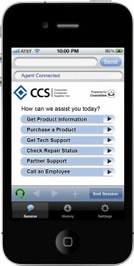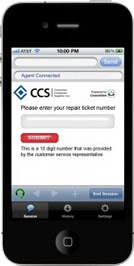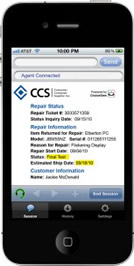The ChoiceView Visual IVR
ChoiceView Visual IVR Brochure ![]()
The Reality of Interactive Voice Response (IVR) Systems
Contact just about any company these days, and you are typically greeted by some type of self-service interactive voice response (IVR) system that asks you to listen to a labyrinth of menu options and respond by pressing a number on your telephone keypad or speaking in your natural voice. All of this occurs before you are able to speak to a service agent, and by then, you may have hung up.
Most callers consider IVR systems a “serious pain.” A recent Purdue University study revealed that 92 percent of US consumers form their image of a company based on their experience using the company’s call center. More strikingly, the study found that 63 percent of consumers stop using a company’s products based on a negative call center experience. That number rises to 100 percent for consumers between ages 18 and 25.
The call center experience starts with the IVR…
According to Boston-based consultancy Yankee Group, “If self-service is not done right, the results can be worse than not doing it at all. Failure can result in increased call volumes, dissatisfied customers and defections.” Poor application design can also increase agent turnover, as customers take out their frustrations on harried agents.
Easing the Pain –
“One Picture is Worth a Thousand Words”
 With a ChoiceView true Visual IVR, your customers can both hear and see information transmitted by your IVR system. With the ChoiceView App on their mobile device or browser, callers instantly see the menu options instead of listening to long sequential lists. They quickly navigate the phone tree submenus by tapping selections from a ChoiceView visual menu sent by your IVR. They see the visual responses instead of only hearing lengthy, audible messages. To show what they’re calling about, callers send photos, video clips, forms, and text to the IVR. More calls are efficiently completed at the IVR without live agents.
With a ChoiceView true Visual IVR, your customers can both hear and see information transmitted by your IVR system. With the ChoiceView App on their mobile device or browser, callers instantly see the menu options instead of listening to long sequential lists. They quickly navigate the phone tree submenus by tapping selections from a ChoiceView visual menu sent by your IVR. They see the visual responses instead of only hearing lengthy, audible messages. To show what they’re calling about, callers send photos, video clips, forms, and text to the IVR. More calls are efficiently completed at the IVR without live agents.
Visual information increases understanding by 600 percent or more (Brain Rules). A Yankee Research study found that 87 percent of respondents prefer to use a Visual IVR to complete their request faster and to seamlessly transfer to an agent if needed without repeating their information. Also, 78 percent stated that Visual IVRs would improve their opinion of the organizations and/or they would chose to do business with them more often.
Competitive Leap in IVR Technology
ChoiceView allows you to offer innovative ways to interact with your callers while decreasing your call processing expenses and improving the overall customer experience. The ChoiceView API for Visual IVRs allows existing and new IVR systems from many vendors to be transformed, with script changes only, into efficient, true Visual IVRs. ChoiceView is a giant leap forward in comparison to the standard IVR interface of voice prompts and touchtone/DTMF (dual tone multi frequency entry).
More Completed Transactions in Less Time, Less Cost
ChoiceView-enabled IVRs increase caller productivity by decreasing transaction time and abandonment rates. Callers see and hear information simultaneously. They find ChoiceView easy to use, allowing them to be more efficient, obtain information quickly and accurately, make better selections and enhance their experience with your organization. Your organization, in turn, reduces operating costs, retains more customers, and increases profits.
ChoiceView IVR Capabilities NOW!
- Learn more at www.TrueVisualivr.com
- Outsource your IVR needs to run on Radish’s or another ChoiceView Alliance member’s hosted IVR.
- Hire Radish’s or another ChoiceView Alliance member’s professional services to transform your IVR.
Provide Better Product Support
Remembering which option to select can be difficult when presented with a long, sequential list of voice-only options. With ChoiceView, all options are seen visually—they’re delivered instantly to a mobile device or browser. For example, a caller contacts his ChoiceView-enabled PC supply company about the status of his PC repair. The caller [1] sees a visual menu of the options and quickly taps the Check Repair Status option and [2] is presented with another screen to enter his repair ticket number. He immediately [3] receives the status information and understands when his PC will be returned. He saves this visual information by tapping ‘+’ on the ChoiceView screen and later reviews it by pressing ‘History.’ The entire ChoiceView transaction takes half the typical call time and the caller is pleased with the efficient service.



